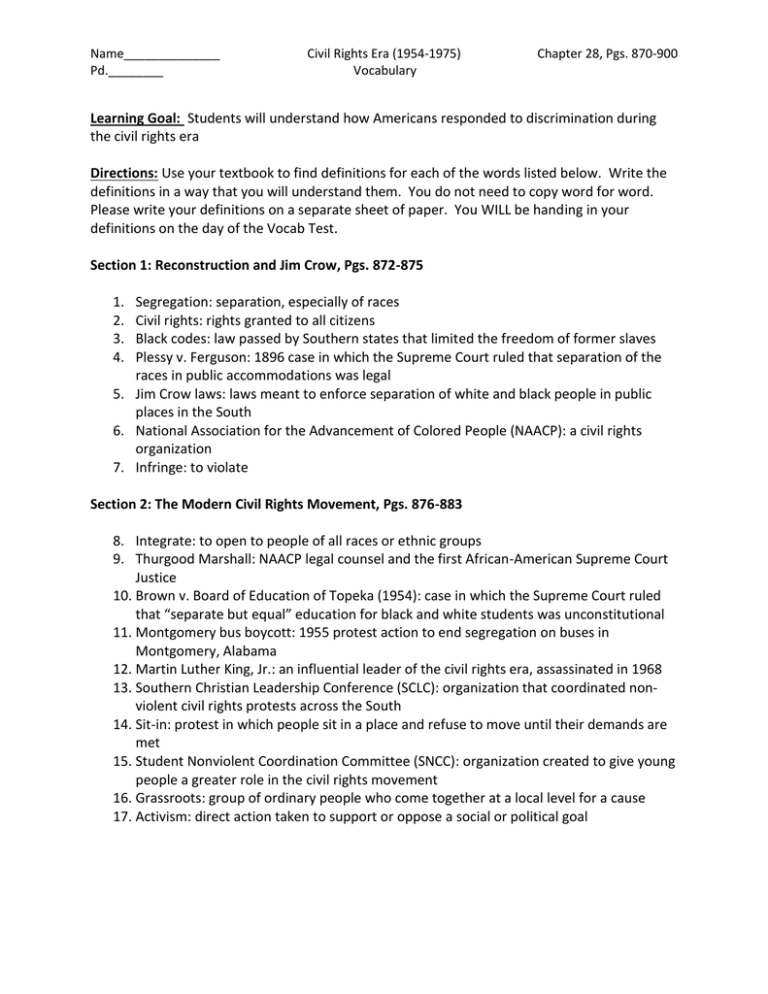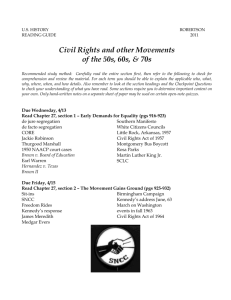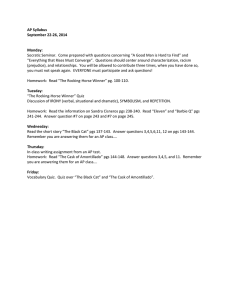Name______________Civil Rights Era (1954
advertisement

Name______________ Pd.________ Civil Rights Era (1954-1975) Vocabulary Chapter 28, Pgs. 870-900 Learning Goal: Students will understand how Americans responded to discrimination during the civil rights era Directions: Use your textbook to find definitions for each of the words listed below. Write the definitions in a way that you will understand them. You do not need to copy word for word. Please write your definitions on a separate sheet of paper. You WILL be handing in your definitions on the day of the Vocab Test. Section 1: Reconstruction and Jim Crow, Pgs. 872-875 1. 2. 3. 4. Segregation: separation, especially of races Civil rights: rights granted to all citizens Black codes: law passed by Southern states that limited the freedom of former slaves Plessy v. Ferguson: 1896 case in which the Supreme Court ruled that separation of the races in public accommodations was legal 5. Jim Crow laws: laws meant to enforce separation of white and black people in public places in the South 6. National Association for the Advancement of Colored People (NAACP): a civil rights organization 7. Infringe: to violate Section 2: The Modern Civil Rights Movement, Pgs. 876-883 8. Integrate: to open to people of all races or ethnic groups 9. Thurgood Marshall: NAACP legal counsel and the first African-American Supreme Court Justice 10. Brown v. Board of Education of Topeka (1954): case in which the Supreme Court ruled that “separate but equal” education for black and white students was unconstitutional 11. Montgomery bus boycott: 1955 protest action to end segregation on buses in Montgomery, Alabama 12. Martin Luther King, Jr.: an influential leader of the civil rights era, assassinated in 1968 13. Southern Christian Leadership Conference (SCLC): organization that coordinated nonviolent civil rights protests across the South 14. Sit-in: protest in which people sit in a place and refuse to move until their demands are met 15. Student Nonviolent Coordination Committee (SNCC): organization created to give young people a greater role in the civil rights movement 16. Grassroots: group of ordinary people who come together at a local level for a cause 17. Activism: direct action taken to support or oppose a social or political goal Name______________ Pd.________ Civil Rights Era (1954-1975) Vocabulary Chapter 28, Pgs. 870-900 Section 3: Kennedy, Johnson, and Civil Rights, Pgs. 884-893 18. Freedom Rides: protests against segregation on interstate busing in the South 19. Congress of Racial Equality (CORE): organization that planned Freedom Rides 20. March on Washington: huge civil rights demonstration in Washington, D.C., in 1963 21. Civil Rights Act of 1964: law banning segregation in public places and creating the Equal Employment Opportunity Commission 22. Freedom Summer: 1964 voter-registration drive for Southern blacks 23. Voting Rights Act of 1965: law banning literacy tests and other laws that kept blacks from registering to vote 24. Great Society: President Johnson’s programs to help the poor, elderly, and women 25. Malcolm X: African-American activists killed in 1965 26. Disenfranchised: people deprived of legal rights, especially the right to vote Section 4: The Equal Rights Struggle Expands. Pgs. 894-900 27. Dolores Huerta: Mexican-American union organizer and negotiator 28. Cesar Chavez: Mexican-American union organization and leader 29. National Congress of American Indians (NCAI): organization founded in 1944 to promote rights of Native Americans 30. Betty Friedan: women’s rights leader and author of “The Feminine Mystique” 31. National Organization for Women (NOW): organization founded in 1966 to get women good jobs at equal pay 32. Equal Rights Amendment (ERA): amendment proposed that would give equality of rights regardless of sex 33. Latinos: people in the United States who trace their origins to Latin American countries and cultures 34. Abridged: shortened 35. Assimilate: to blend into society






